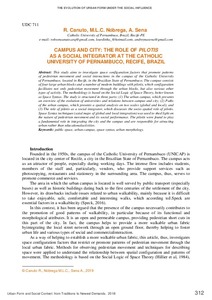CAMPUS AND CITY: THE ROLE OF PILOTIS AS A SOCIAL INTEGRATOR AT THE CATHOLIC UNIVERSITY OF PERNAMBUCO, RECIFE, BRAZIL
Скачать файл:
URI (для ссылок/цитирований):
https://elib.sfu-kras.ru/handle/2311/111702Автор:
Canuto, R.
Nóbrega, M.L.C.
Sena, A.
(Canuto, R., Nóbrega, M.L.C., Sena, A.: Catholic University of Pernambuco, Brazil, Recife-PE e-mail: robsoncanuto.arq@gmail.com, lourdinha_@hotmail.com, andreynasena@gmail.com)
Дата:
2019-05Proceedings of the XXV ISUF International Conference “Urban Form and Social Context: from Traditions to Newest Demands” (Krasnoyarsk, July 5–9, 2018)
Аннотация:
This study aims to investigate space configuration factors that promote patterns of pedestrian movement and social interactions in the campus of the Catholic University of Pernambuco, located in Recife, in the Brazilian State of Pernambuco. The campus consists of four large urban blocks and a number of modern buildings with pilotis, which configuration facilitates not only pedestrian movement through the urban blocks, but also various other types of activity. The methodology is based on the Social Logic of Space Theory, better known as Space Syntax. The study is structured in three parts: (1) The urban campus, which presents an overview of the evolution of universities and relations between campus and city; (2) Paths of the urban campus, which presents a spatial analysis on two scales (global and local); and (3) The role of pilotis as a social integrator, which discusses the socio-spatial role of pilotis. Space Syntax techniques (axial maps of global and local integration) was used to shed light on the nature of pedestrian movement and its social performance. The pilotis were found to play a fundamental role in integrating the city and the campus and are responsible for attracting urban rather than educationalactivities.

